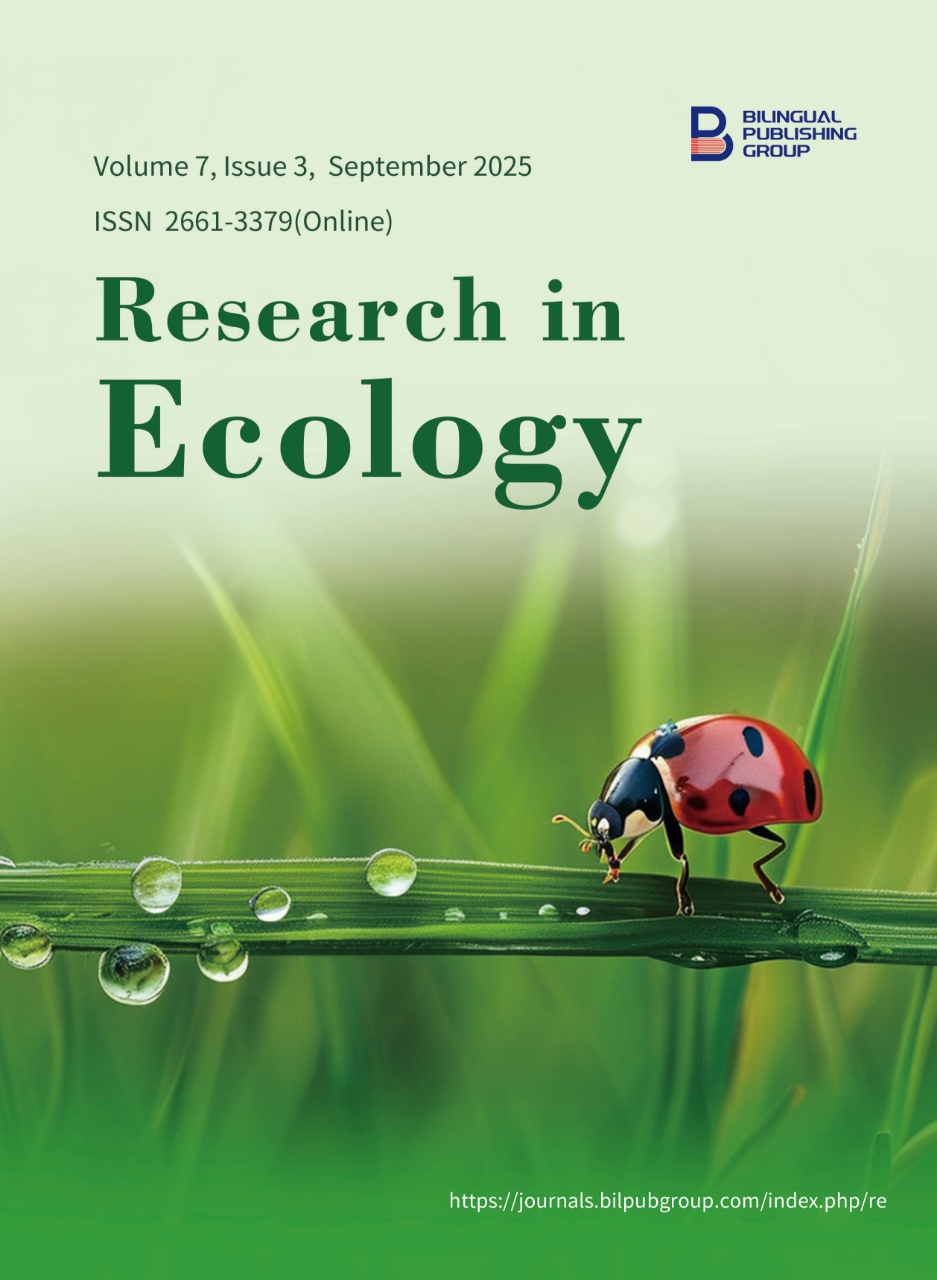
Long-Term Flood Inundation Trends and Their Effects on Diverse Agricultural Systems in Ben Tre of Vietnam
DOI:
https://doi.org/10.30564/re.v7i3.10068Abstract
The Vietnamese Mekong Delta (VMD), a critical agricultural hub, faces recurrent flooding that poses substantial threats to livelihoods and productivity. Ben Tre province, with its low-lying coastal terrain, is particularly vulnerable. Effective risk management and sustainable agricultural development necessitate a thorough understanding of these flood dynamics. This study leveraged the Google Earth Engine (GEE) platform and Sentinel-1 Synthetic Aperture Radar (SAR) imagery to analyze flood inundation patterns and their impacts on diverse agricultural land uses in Ben Tre province from 2015 to 2023. The methodology involved SAR data pre-processing, Otsu thresholding for water body delineation from VH polarization data and change detection using a 2020 land use map to quantify annual flooded areas and their impact on specific agricultural categories. The total inundated area peaked in 2018 at 58,334 ha, a significant increase from 27,934 ha in 2015, before stabilizing around 42,000–44,000 ha in 2021–2023. Flooded agricultural land mirrored this trend, increasing from 18,615 ha (2015) to a peak of 39,514 ha (2018), then decreasing to 28,841 ha (2023). Notably, wet rice cultivation experienced a 37.8% increase in its flooded area over the study period, while other annual crops and perennial crops saw increases of 38.9% and 68.4%, respectively. This research demonstrates the GEE platform's efficacy with Sentinel-1 SAR for robust, long-term flood monitoring and impact assessment, revealing escalating flood pressure on key agricultural systems and an expansion of flooding beyond traditional low-lying zones, providing crucial data for adaptive land use planning.
Keywords:
Agricultural Impact; Flood Mapping; Google Earth Engine; Remote Sensing; Sentinel-1; Vietnamese Mekong DeltaReferences
[1] Jonkman, S.N., 2005. Global Perspectives on Loss of Human Life Caused by Floods. Nat Hazards. 34, 151–175. DOI: https://doi.org/10.1007/s11069-004-8891-3
[2] Doocy, S., Daniels, A., Murray, S., et al., 2013. The human impact of floods: a historical review of events 1980-2009 and systematic literature review. PLoS Currents. 5. DOI: https://doi.org/10.1371/currents.dis.f4deb457904936b07c09daa98ee8171a
[3] Nguyen, C.T., Schwarzer, K., Ricklefs, K., 2023. Water-level changes and subsidence rates along the Saigon-Dong Nai River Estuary and the East Sea coastline of the Mekong Delta. Estuarine, Coastal and Shelf Science. 283, 108259.
[4] Nicholls, R.J., Lincke, D., Hinkel, J., et al., 2021. A global analysis of subsidence, relative sea-level change and coastal flood exposure. Nature Climate Change. 11, 338–342. DOI: https://doi.org/10.1038/s41558-021-00993-z
[5] Syvitski, J., Kettner, A., Overeem, I., et al., 2009. Sinking deltas due to human activities. Nature Geoscience. 2, 681–686. DOI: https://doi.org/10.1038/ngeo629
[6] Eslami, S., Hoekstra, P., Nguyen Trung, N., et al., 2019. Tidal amplification and salt intrusion in the Mekong Delta driven by anthropogenic sediment starvation. Scientific Reports. 9, 18746. DOI: https://doi.org/10.1038/s41598-019-55018-9
[7] Wassmann, R., Hien, N.X., Hoanh, C.T., et al., 2004. Sea Level Rise Affecting the Vietnamese Mekong Delta: Water Elevation in the Flood Season and Implications for Rice Production. Climatic Change. 66, 89–107. DOI: https://doi.org/10.1023/B:CLIM.0000043144.69736.b7
[8] Smajgl, A., Toan, T., Nhan, D., et al., 2015. Responding to rising sea levels in the Mekong Delta. Nature Climate Change. 5, 167–174. DOI: https://doi.org/10.1038/nclimate2469
[9] General Statistics Office, 2022. Statistical Yearbook of Viet Nam 2022. Statistical Publishing House. p. 1267.
[10] Nguyen, V.K.T., Nguyen, V.D., Hoang, L.P., et al., 2020. Future projections of flood dynamics in the Vietnamese Mekong Delta, Science of The Total Environment. 742, 140596. DOI: https://doi.org/10.1016/j.scitotenv.2020.140596
[11] Yuen, K.W., Hanh, T., Quynh, V.D., et al., 2021. Interacting effects of land-use change and natural hazards on rice agriculture in the Mekong and Red River deltas in Vietnam. Natural Hazards and Earth System Sciences. 21, 1473–1493. DOI:https://doi.org/10.5194/nhess-21-1473-2021
[12] Triet, N.V.K., Dung, N.V., Merz, B., et al., 2018. Towards risk-based flood management in highly productive paddy rice cultivation – concept development and application to the Mekong Delta. Natural Hazards and Earth System Sciences. 18, 2859–2876. DOI: https://doi.org/10.5194/nhess-18-2859-2018
[13] Tran, T.A., 2019. Land use change driven out-migration: Evidence from three flood-prone communities in the Vietnamese Mekong Delta. Land Use Policy. 88, 104157. DOI: https://doi.org/10.1016/j.landusepol.2019.104157
[14] Phuong, T.T., Vien, T.D., Son, C.T., et al., 2024. Impact of Climate Change on Agricultural Production and Food Security: A Case Study in the Mekong River Delta of Vietnam. Sustainability. 16(17), 7776.
[15] Gupta, J., Scholtens, J., Perch, L. et al., 2020. Re-imagining the driver–pressure–state–impact–response framework from an equity and inclusive development perspective. Sustainability Science. 15, 503–520. DOI: https://doi.org/10.1007/s11625-019-00708-6
[16] Schumann, G., Baldassarre, G.D., Bates, P., 2009. The Utility of Spaceborne Radar to Render Flood Inundation Maps Based on Multialgorithm Ensembles. IEEE Transactions on Geoscience and Remote Sensing. 47, 2801-2807. DOI: https://doi.org/10.1109/TGRS.2009.2017937
[17] Schumann, G.J.P., Moller, D.K., 2015. Microwave remote sensing of flood inundation. Physics and Chemistry of the Earth, Parts A/B/C. 83–84, 84–95. DOI: https://doi.org/10.1016/j.pce.2015.05.002
[18] Feyisa, G.L., Meilby, H., Fensholt, R., et al., 2014. Automated Water Extraction Index: A new technique for surface water mapping using Landsat imagery. Remote Sensing of Environment. 140, 23-35. DOI: https://doi.org/10.1016/j.rse.2013.08.029
[19] Martinis, S., Kersten, J., Twele, A., 2015. A fully automated TerraSAR-X based flood service. ISPRS Journal of Photogrammetry and Remote Sensing. 104, 203-212. DOI: https://doi.org/10.1016/j.isprsjprs.2014.07.014
[20] Kuenzer, C., Guo, H., Huth, J., et al., 2013. Flood Mapping and Flood Dynamics of the Mekong Delta: ENVISAT-ASAR-WSM Based Time Series Analyses. Remote Sensing. 5(2), 687-715. DOI: https://doi.org/10.3390/rs5020687
[21] Gorelick, N., Hancher, M., Dixon, M., et al., 2017. Google Earth Engine: Planetary-scale geospatial analysis for everyone. Remote Sensing of Environment. 202, 18 – 27.
[22] Tamiminia, H., Salehi, B., Mahdianpari, M., et al., 2020. Google Earth Engine for geo-big data applications: A meta-analysis and systematic review. ISPRS Journal of Photogrammetry and Remote Sensing. 164, 152-170. DOI: https://doi.org/10.1016/j.isprsjprs.2020.04.001.
[23] Amani, M., Ghorbanian, A., Ahmadi, A.A., et al., 2020. Google Earth Engine Cloud Computing Platform for Remote Sensing Big Data Applications: A Comprehensive Review. IEEE Journal of Selected Topics in Applied Earth Observations and Remote Sensing. 13, 5326-5350.
[24] Uddin, K., Matin, M. A., 2021. Potential flood hazard zonation and flood shelter suitability mapping for disaster risk mitigation in Bangladesh using geospatial technology. Progress in Disaster Science. 11, 100185. DOI: https://doi.org/10.1016/j.pdisas.2021.100185.
[25] Bui, P.Q.N., Pal, I., Chollacoop, N., et al., 2022. Applying Google earth engine for flood mapping and monitoring in the downstream provinces of Mekong river. Progress in Disaster Science. 14, 100235.
[26] Mai, S.H., Luu, C., Bui, Q.D., et al., 2023. Urban flood risk assessment using Sentinel-1 on the google earth engine: A case study in Thai Nguyen city, Vietnam. Remote Sensing Applications: Society and Environment. 31, 100987.
[27] Ben Tre Statistical Office. 2023. Statistical Yearbook of Ben Tre 2022. Ho Chi Minh City General Publisher.
[28] Otsu, N., 1979. A threshold selection method from gray-level histograms. IEEE Transactions on Systems, Man, and Cybernetics. 9(1), 62-66.
[29] Liu, D., Yu, J., 2009. Otsu method and K-means. In: 2009 Ninth International conference on hybrid intelligent systems. IEEE. 1. 344-349.
[30] Tran., K. H., Menenti, M., Li, J., 2022. Surface Water Mapping and Flood Monitoring in the Mekong Delta Using Sentinel-1 SAR Time Series and Otsu Threshold. Remote Sensing. 14(22), 5721.
Downloads
How to Cite
Issue
Article Type
License
Copyright © 2025 Tran Xuan Dung, Thi Diem Quy Phan

This is an open access article under the Creative Commons Attribution-NonCommercial 4.0 International (CC BY-NC 4.0) License.




 Tran Xuan Dung
Tran Xuan Dung






